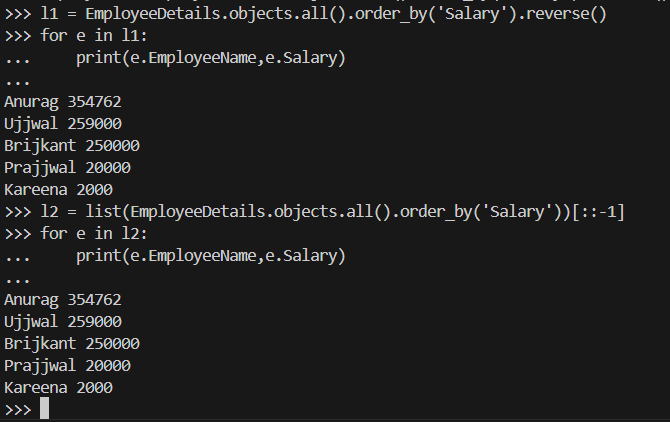Django Query Set Order By (original) (raw)
Last Updated : 22 May, 2025
**order_by() method in Django QuerySets is used to **sort query results based on one or more fields, either in **ascending or **descending order. This helps display data sorted by criteria like salary, name, date, etc., directly from the database query.
In this article we will learn all about order_by method of QuesrySets by performing multiple operations over a dataset, for this we need to first create a model
Creating Model: EmployeeDetails
Assuming you have the following model defined in **models.py:
Python `
from django.db import models
class EmployeeDetails(models.Model): EmployeeId = models.AutoField(primary_key=True) EmployeeName = models.CharField(max_length=20) EmployeeDepartment = models.CharField(max_length=20, blank=True, null=True) Country = models.CharField(max_length=20, blank=True, null=True) Salary = models.IntegerField(blank=True)
def __str__(self):
return self.EmployeeName`
Make sure you have migrated this model:
python manage.py makemigrations
python manage.py migrate
**Add some sample data via the Django admin or shell before testing.

Snapshot of Database after adding some dummy entries
Using order_by() in the Django Shell
Open the Django shell:
python manage.py shell
1. Sort Employees in Ascending Order by Salary
Python `
from yourapp.models import EmployeeDetails
Retrieve all employees ordered by Salary (lowest first)
employees = EmployeeDetails.objects.all().order_by('Salary') for emp in employees: print(emp.EmployeeName, emp.Salary)
`
This will display employees starting from the lowest salary:

Snapshot of shell
2. Sort Employees by Salary in Descending Order
Python `
Using '-' prefix to sort descending by Salary
employees = EmployeeDetails.objects.all().order_by('-Salary') for emp in employees: print(emp.EmployeeName, emp.Salary)
`
The '**-' before the field name **reverses the order, so the highest salaries appear first:

Snapshot of shell
3. Alternative Descending Order Approaches (Not Recommended)
Python `
Approach 1: Reverse the QuerySet after ascending order
employees = EmployeeDetails.objects.all().order_by('Salary').reverse()
Approach 2: Using Python list slicing (less efficient)
employees = list(EmployeeDetails.objects.all().order_by('Salary'))[::-1]
for emp in employees: print(emp.EmployeeName, emp.Salary)
`
While these work, using ****'-Salary'** in **order_by() is faster and preferred:

Snapshot of shell
4. Sort by Multiple Fields
Python `
Order first by Salary ascending, then by EmployeeName ascending
employees = EmployeeDetails.objects.all().order_by('Salary', 'EmployeeName') for emp in employees: print(emp.EmployeeName, emp.Salary)
`
Employees are sorted by salary, when salaries are equal, they are sorted alphabetically by name:

Snapshot of shell
Unfortunately, in the above example, our database have no entries with same salaries and thats why the output looks like a regular salary based sorted list